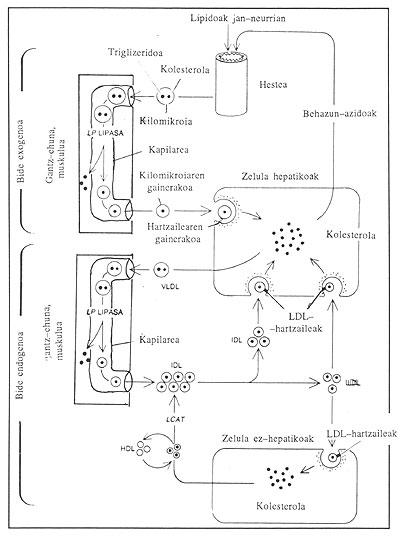Cholesterol and our health
1988/10/01 Gonzalez, Edorta | Garcia, Oscar Iturria: Elhuyar aldizkaria
Half of the deaths in the industrialized countries are responsible for arteriosclerosis. The main characteristic of this disease is the accumulation of cholesterol in the arterial walls.
Biological basis of the disease
A person's daily cholesterol needs are 800 mg. Cholesterol can be swallowed externally or synthesized in the liver. If taken from the outside, the liver does not synthesize.
The endogenous synthesis, that of the liver, contains 45 biochemical reactions with many other enzymes.
Rule B) Article 5.
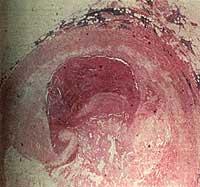
In all these enzymes we will only mention the first, Hydroxymethylglutaril KoA reducttase or, briefly, HMG KoA. This controls the whole process.
That as for the liver. The rest of the organs collect the cholesterol they need through the blood.
Cholesterol is a lipid and therefore, like all lipids, insoluble in water. The blood carries cholesterol along with lipoproteins, with which it generates complexes.
Lipoproteins, as the name suggests, contain lipids and proteins and are very important. The more LDL, low-density lipoproteins, the more developed will be arteriosclerosis.
When the cholesterol level rises, the risk of arterosclerosis increases and appears associated with the growth of the LDL circulating.
This apoprotein B-100, located in the outer hydrophilic cover, is rereconocide and associated with the LDL receptor.
The LDL receptor is glycoprotein, that is, contains protein and sugar and, as mentioned above, is associated with apoproteins B-100 and/or E. This link also occurs in very low concentrations, 10-9M. In other words, the receptor can take LDL despite being among one billion water molecules. As can be seen, LDL (containing cholesterol) is very easily associated with LDL receptors. Then it is introduced into the inside of the cell by the degradation of the ldl cover by the enzymes of lysosoma in a lysosome, and after breaking the ester bond, the cholesterol leaves the lysosome. We already have it inside the cell.
But what are the functions of cholesterol? What is it for?
- Go to the newly built languages. Participate in the hormones cortisol and estradiol.
- To convert them into mop acid and subsequently, by their hepatic secretion to intestine, participate in digestion.
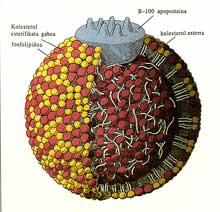
If cholesterol accumulates (it is always meant within the cell), 3 processes occur:
- Inhibition of the synthesis of cholesterol. The synthesis of the enzyme HMG KoA reductase is interrupted, so no more cholesterol is produced. Accumulation of cholesterol esters.
- The genetic synthesis of the new LDL receptors is broken, so we have fewer LDL receptors in the membranes.
Most organs have cells with LDL receptors, but the liver, adrenal capsules, and the ovary have much more, as these organs need more cholesterol.
Origin of circulating LDL
The lipid transport system can be done by two ways: an exogenous one (for triglycerides absorbed by cholesterol and intestine) and another endogenous one (for triglycerides and cholesterol that come to the blood from the liver and other non-intestinal tissues).
We know that there are two paths that are reflected in the image.
Exogenous route: The lipids of the food measurement are introduced in the form of lipoproteins, called kilomicrois, which leave triglycerides to the fatty tissue (to store them) and muscle (to produce oxidation and energy) once they circulate.
Endogenous route: The liver contributes VLDL (very low density lipoproteins) to the blood. These new lipoproteins are formed by triglycerides synthesized in the liver. Cholesterol esters and two apoproteins (apoproteins B-100 and apoproteins E) appear.
When a VLDL particle reaches the capillaries of adipose tissue or muscle, the triglycerides it carries are obtained from it. The rest becomes IDL (medium density lipoprotein). Half of these IDL particles disappear quickly (from two to six hours) by ingestion of livers. Uncaptured IDL particles, after losing apoprotein E, are transformed into LDL, but these LDL molecules that appear last two and a half days in the blood circulation without being associated with LDL receptors.
Familial hypercholesterolemia
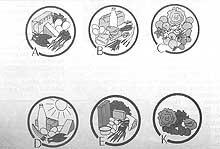
The importance of LDL receptors in the disease of arteriosclerosis was revealed when it was seen that the lack of LDL receptors causes a serious disease, familial hypercholesterolemia (SH). There are two forms of this disease:
- Heterozygous: its frequency is 1:500, the level of LDL of the patients is twice the normal and from the twenty-five years it suffers cardiac infarction.
- Homozygous form: its frequency is 1:1,000,000. Its LDL level is six times higher than normal. Patients suffer from hells from the age of two. As a result, few exceed 20 years. These children have normal blood pressure, do not smoke, and blood glucose data are common. This shows, undoubtedly, the causal relationship between the level of LDL circulating and arteriosclerosis.
For patients with a heterozygous form of disease, a possible route of treatment has been found: the reduction of the cholesterol levels present in the cells helps to the synthesis of LDL receptors. Therefore, a way to reduce cholesterol levels would be to remove bile acids. Thus, the liver should increase the use of cholesterol in the development of bile acids, so the liver cells should make more LDL receptors, which would imply a lower appearance of cholesterol in the blood.
Some medications are known to interrupt the recycling of bile acids: resins. One of them, cholestyramine, known for twenty years, reduces in 10% the levels of LDL in blood, with which infarction decreased in 20% in the median age group. However, a problem appeared. This decrease of 10% at the LDL level, in addition to increasing the production of LDL receptors, affected another process: the increase in the synthesis of the HMG KoA enzyme to increase the production of cholesterol inside the cell.
To avoid all this, two drugs were administered to the patients: on the one hand, the resins that receive bile acids, previously mentioned, and on the other, the inhibitors of the reduction HMG KoA and the drugs of conpatine and mebinoline that inhibit the synthesis of cholesterol.
Trials were conducted with dogs and LDL levels decreased by 75%. The levels of LDL in the case of SH eri heterozygous after having been performed in humans were common. It can be said that the disease of the heterocinate SH was compact, but for homocycats SH had to find another solution, vaccination.
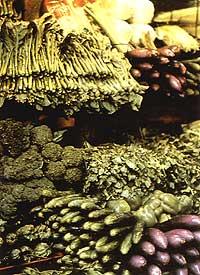
After the introduction of the liver with a normal donor to the patient, its cholesterol level went from 1200 mg/dL to 300 mg/dL (almost twice as normal), but four times lower than it was. As can be seen, although it is not the best cure, it can be considered very positive.
And the point that touches now is another: What is happening in the industrialized countries so that many people without genetic errors will suffer a stroke? The arteriosclerosis that most people suffer is due to a too high level of LDL, whose origin should be sought in an error in the production of LDL receptors. There is a small number of LDL receptors, since their production is limited by genetic and environmental factors. One of them is the food.
Our diet is rich in saturated fats of animal origin and cholesterol. But this is not the only factor. Both hormones, estradiol and thyroid, contribute to the production of hepatic LDL receptors. Therefore, the possible discomfort in these two hormones can reduce cholesterol levels.
The optimal concentration of LDL in blood for receptors is 50 mg/dl. However, in the West the normal level is 125 mg/dl. The food needed to maintain this level is far from the one in the industrialized countries and is more drunk than the low cholesterol content recommended by the American Cardiac Organization. This measure would mean the elimination of dairy and eggs, and the exclusion of foods rich in meat and saturated fat.
Natural ways to escape cholesterol
With the aim of not suffering the aforementioned diseases, more and more people strive to buy foods that do not raise or, if possible, lower cholesterol levels. The easiest way to reduce cholesterol levels is to certainly reduce egg consumption, but there are also other ways to do so. For starters, it would not be wrong that instead of going to supermarkets go more to the vegetable store. In fact, vegetables and fruits can be of great help in the anti-cholesterol buzz. Yogurt and polysaturated oils, along with physical exercise, help us to control our enemy. Let's see it one by one.
I. Eggplant Eggplant
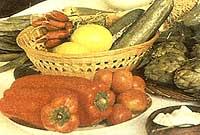
This meal is not top of the list by flute, as it helps to remove fats taken in the same meal. The products that are produced on the plates of this vegetable are associated with fats, avoiding their absorption.
II. Artichokes Artichokes
It is a general tonic that acts as hepatic antitoxic and prevents the accumulation of cholesterol in body grinding, favoring its expulsion. The artichoke or artichoke chips are raw and cooked legs in a few waters. In this last case it is recommended to drink cooking water.
The artichoke favors biliary secretion and also presents hypoglycemic characteristics that reduce the presence of sugars in the urine of diabetics.
III. Garlic and onion
In most breakfasts there are wipes with butter that raise cholesterol levels. To avoid it we can rub the toast with garlic.
In the sessions developed by Hindu researchers it has been shown that the introduction of garlic in the diet prevents the absorption of cholesterol and the increase of its blood level. According to studies, breakfasts with tosts and butter raise cholesterol by 20%. When rubbing the bread with numerous garlic does not appear this increase. Garlic, accompanied by fatty foods, contributes to the increase in high-density lipoproteins (HDL), which are protective against arteriosclerosis. As mentioned above, harmful are low-density lipoproteins (LDL).
On the other hand, garlic is of great help for those who suffer hypertension. For people with arteriosclerosis and hypertension, taking two or three garlic cloves a day can be very healthy. The only problem, of course, is its smell.
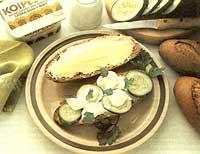
The raw onion contains vitamins and minerals and acts hypotensor in the cases of arteriosclerosis. In addition, its silica eases the arteries.
IV. Leguminous greens
Green beans to combat arteriosclerosis are very good, as they reduce the number of LDL, and this without the HDL decreases the level of high-density lipoproteins. This last point is very interesting as the HDL are sponsors.
Soy and its derivatives are very rich in proteins and very used in vegetarian and oriental food. Soy based diet decreases the level of cholesterol from the first day, according to studies carried out in plants.
Vegetables that do not consume eggs or dairy products have very low levels of cholesterol and LDL.
V. V. Vegetable fiber
In the Anglo-Saxon villages, oatmeal flakes are often consumed. Once a day, about 125g, cholesterol levels are reduced by 8% thanks to the vegetable fiber that contains oatmeal flakes after three weeks. According to other studies, oatmeal of 140 g of food a day reduces cholesterol by 11% from the third week.
Vegetable fiber facilitates the passage of food products above the sausage, which reduces the absorption of cholesterol.
Among the vegetable fibers, pectin stands out. It is present in numerous vegetables and fresh fruits, especially in apples and its bark. The pectin from there is triple the pectin in the apple. Therefore, bleaching means the loss of vegetable fiber.
VI. Types of oil
The healthiest vegetable oils are, without a doubt, polysaturated, such as soy and corn oil.
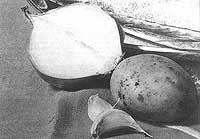
Sunflower oils and blended oils of soy and sunflower can benefit from arteriosclerosis.
Olives and olives, although less favorable than the previous ones, affect the gallbladder and help to bile secretion. This is why they are used to treat gallstones. Virgin olive oil reduces cholesterol levels if it is not mixed with other fats. In that case, the effect on cholesterol is unfavorable.
Butter and fat are very harmful and should be eradicated. Skimmed milks are not recommended, as they raise cholesterol levels. Yes, they can help keep fit.
VII. Vitamins and trace elements
Against cardiovascular diseases, some vitamins are very interesting: For example, vitamin C and vitamin E, and foods that contain them. As a result, blood HDL levels increase, being more protected against cholesterol.
Among the trace elements, the most remarkable is Magnesium, which together with the first vitamins is found in some common sources of brewer's yeast, salt, chilled wheat, whole grains, molasses and vitamin C: lemon, kiwi, parsley, feather, berro, astalarrosa and other fruits and vegetables. We will again mention: to overcome arteriosclerosis, we must direct the first steps towards horticulture.
As for lecithin, according to some dieticians, it is the panacea against cholesterol. It is found in the yolk, chilled wheat, whole crops and other seeds such as sunflower, soy, almonds and nuts. Lecithin emulsifies fats, that is, dissolves the cholesterol deposits. The droplets of cholesterol that appear as a result of this process can be more easily metabolized by our organism.
VIII. Yogurt yogurt
The bacteria used in the fermentation of yogurt, Lactobacillus bulgaricus, lowers blood cholesterol levels, avoiding the synthesis of this product in the liver.
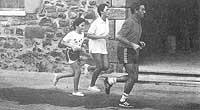
Some doctors still advise taking skimmed milk, but are wrong and if we really want to take an effective anti-cholesterol product, we would recommend taking it.
IX. Physical exercises Physical exercises
People who practice some sport, jogging or gymnastics have high levels of HDL and are protected against arteriosclerosis. However, we do not have to make great efforts. It is enough to make a fairly long daily journey.
X. Breathing Breathing Breath
Although people think otherwise, many times we do not breathe well and on the other hand we need clean air (without smoke) and this second requirement is not always met.
Smokers' HDL levels are lower than those of non-smokers, although they increase by 30% at two weeks of quitting tobacco. In addition, tobacco uses vitamin C and, as mentioned above, helps to reduce cholesterol levels.
Continuous, abdominal, deep and serene breathing balances the level of cholesterol, as has been shown in people who work in meditation.
Finally, and summarizing some aspects of our behavior, we highlight the need to avoid stress, tobacco and alcohol in this buzz.

Gai honi buruzko eduki gehiago
Elhuyarrek garatutako teknologia




